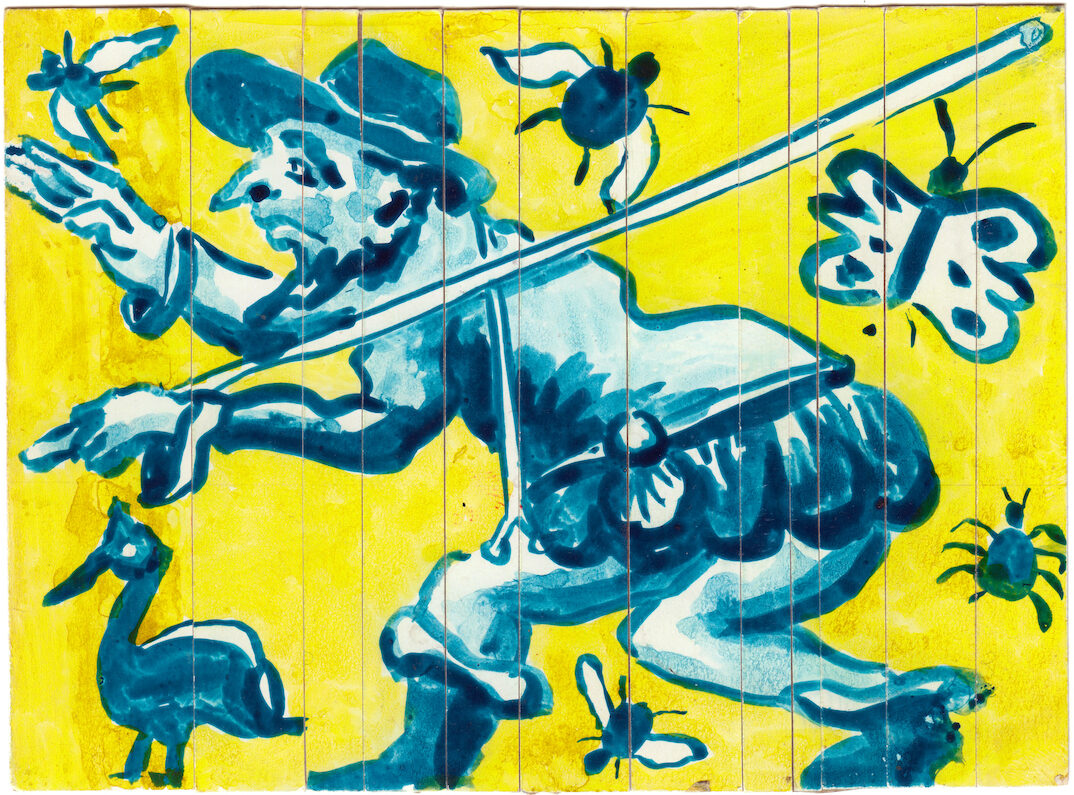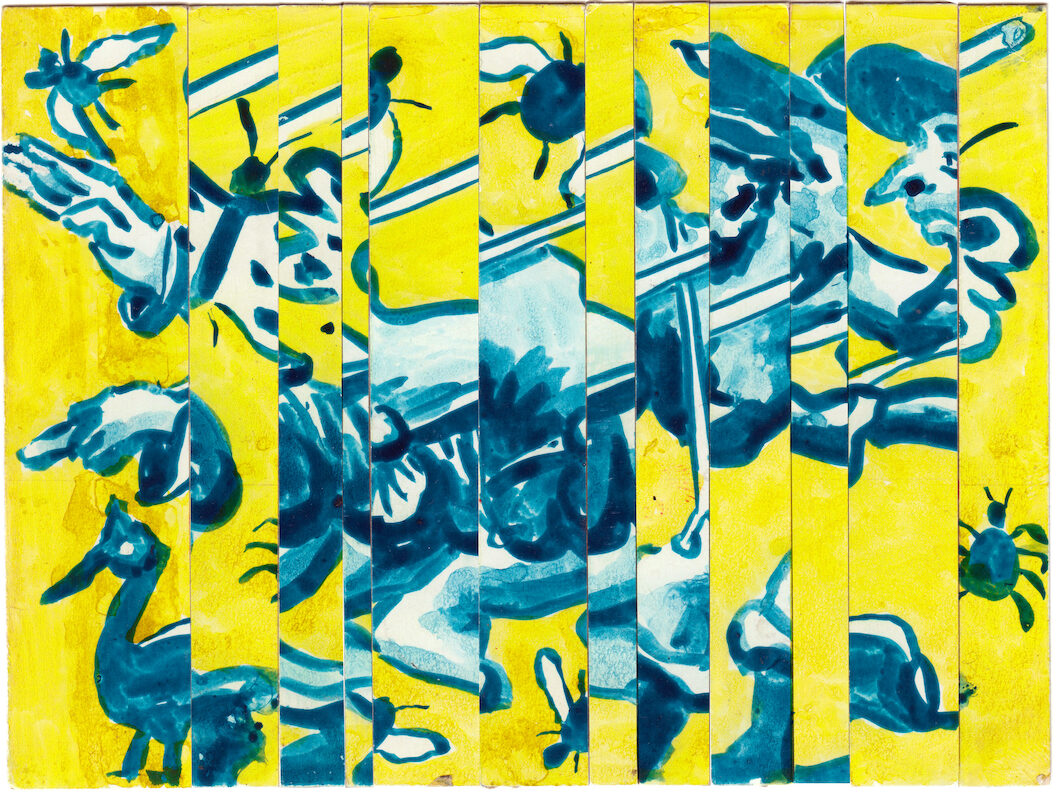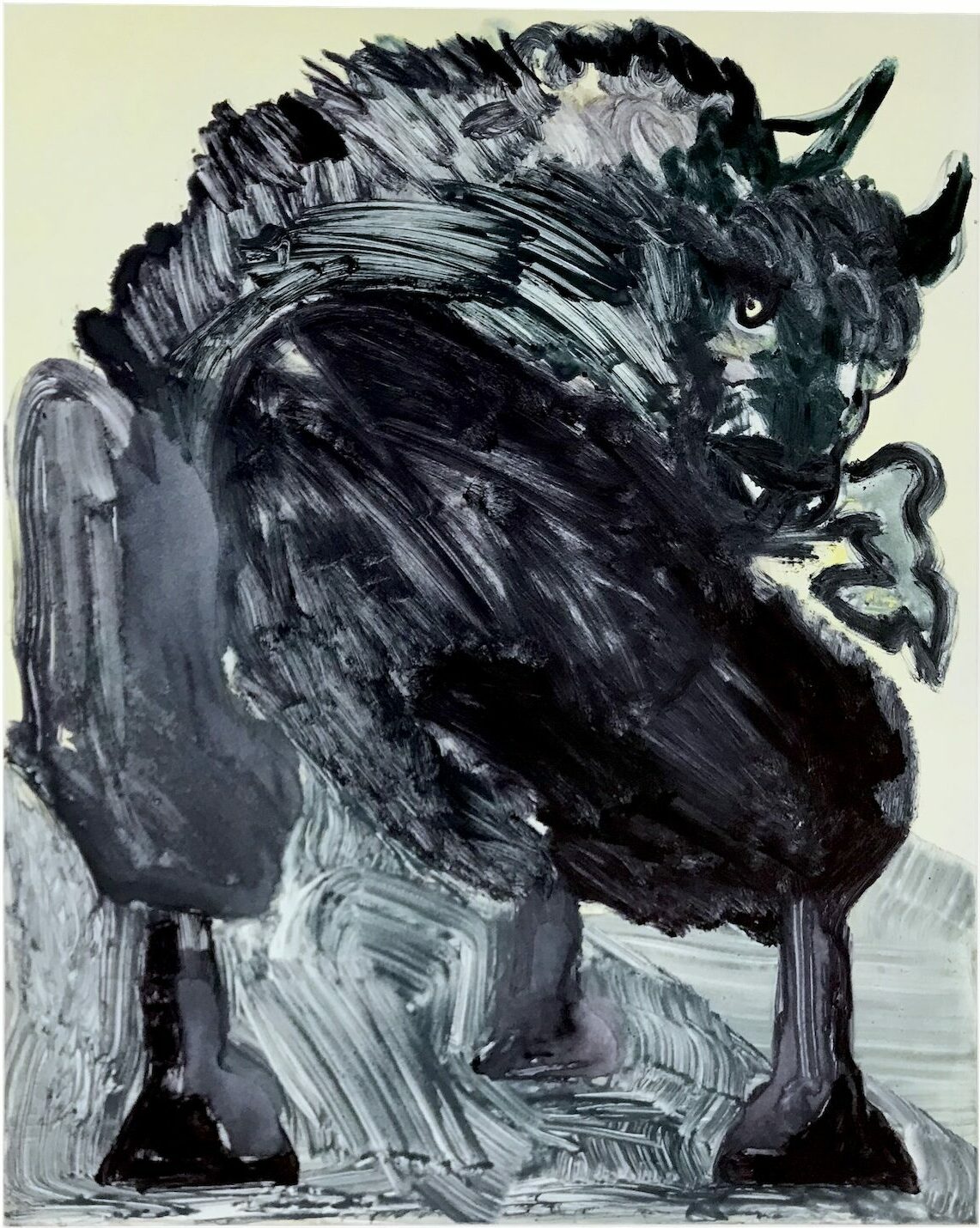Jessica Higgins
Forty eight minutes and seven seconds. The slide reads: Question 2. Gap. Process 1. Next line. Where are your feelings? Next line. Locate them. And the next. Do not analyse. Locate. Line break. Are they in your heart, your stomach – next line – your lungs? Line break. Do not analyse – dot dot dot – locate. Short pause. Question 2. Process 1. Disappears. Short pause. Don’t analyse… locate flashes ten, or maybe eleven times.
![]()
A few years ago scientists plotted a route. It begins in our orb-like guts and the bacteria which reside there, fizzing in last night’s juices. A system of coordinates trails up through the intestines, climbs the spine, reaching all the way to the brain before heading back out again through the body’s intricate and seeping sections. The headline reads: Gut Bacteria Can Influence Your Mood, Thoughts and Brain. L tells us this at work one day as she places down the coffees. We gulp. We gasp. Makes sense. The discovery hangs in the air for a moment. I counter, recalling my new favourite fact. This one goes: sleep has not always, ordinarily, been a singular event. Rather, a night’s rest came with intermissions. Breaks. Pauses. Intervals. Sometimes, there was singing. It was the arrival of industrialisation, and with it the extractive power of the shift pattern which compressed the night into one neatly marked unit.
In Jane Arden’s 1979 film Anti-Clock our protagonist Joseph Sapha is not a shift worker, but a thought reader and professional gambler. He steps up for his performance. The room is full of your thoughts, ladies and gentlemen. And not just your thoughts. Last night’s thoughts. Last week’s thoughts. Endless thoughts. Thoughts hang around for a very long time, ladies and gentlemen. The crowd is silent. Tenter-hooked. Sapha is starkly lit, neon tubes flashing in a gentle rhythm behind him. A guitar melody rolls, reverberating and slightly modulated. Like a graze on the edge of a container. He wraps a slick black blindfold around his head. Ties it. The neons rise and fall in their holding pattern. A slow and measured pulse. He takes the microphone from the stand. We hear it clink and clank. It picks itself up.
Thoughts hang around for a very long time, ladies and gentlemen. To be precise, forever. The music dims and in its absence, the film’s never-quite-quiet intensifies. He continues: tonight, ladies and gentlemen, it is my very great privilege to read your thoughts. Before he does so, Sapha tells us about the Akashic Records. The eternal reality of all thoughts. That is, time’s circle back. Everything happening now, again, and before, it seems. He doesn’t say much more. He just lets us know it’s there, hanging around.
Another year. Another plot. Another day at work. P tells us about time sickness. That is, the notion that sensing time’s lack, its loss, its slip, its speed, can make you unwell. The mention was fleeting. I search for detail. What is this that afflicts us? Time-of-Day-Cue-Conflicts Directly Affect Health. Abstract reads: A daily rhythm that is not in synchrony with the environmental light-dark cycle (as in jet lag and shift work) is known to affect mood and health through an as yet unresolved mechanism. Its symptoms, I learn, are not not like motion sickness. I think of my exhausted gut bacteria and remember Flaubert’s definition of nightmares as things that come from the stomach, whereas dreams are any great ideas one does not understand. Locate the feeling. Is it in your stomach?
![]()
Twelve minutes and eight seconds. A stop frame motion. Sapha pays a bill. Thanks a lot sir. Thank you. The screen glitches. Its juddering feels like a lifetime. His hand reaches for his glass. Orchestration seeps and swells. Marching voices sing out their vague devotion. He, voice in a web, stuck on a refrain – one event – one event – one event – a phone rings. A hand. A reaching. A phrase. A voice from elsewhere speaks in his ear. The clock is the key object of your habit, goals keep you mobile, your relationship with money operates on the primary level and interlocks with time. The voice echoes. Its pronouncements make a scenery, their disintegrative repetition grafting interference patterns into the action. The phone rings again.
![]()
This was Jane’s final film before her suicide in 1982. Its unerring soundtrack is a temporal hash of voices, addressing and broadcasting. A performed record of one way conversations and indiscernible discourse. Meanwhile, a synthetic wheezing makes knots in the fuzz. Like tuning in, or the language I imagine wires might speak. Here, time is giving its testimony in noise. As the opening sequence unfolds, Jane’s voice braces the static. Each phrase lasts a breath, poised between the future and the past while the present sleepwalks by. As the song continues, her voice grows stronger. There, at the chorus, is the throat’s push forward. Its insistence is a thrust of air and will. Locate the feeling. Is it in your lungs?
this is what I really want / this is who I really love / this is what I think I really need.
The music fades and the clamour in Sapha’s ear grows. A montage of television broadcasts heralds a history. Some hungover atmosphere of war, ceremony and imperialism’s ornamentation flickers. This informational decor, a musical pattern for the inner ear, is an infrastructural tissue between the body and networks of power.
this is what I really want / this is who I really love / this is what I think I really need.
Anti-Clock’s companion piece, the book You Don’t Know What You Want, Do You? describes the film’s namesake radio station ANTICLOCK as a countersignal or notch on the tuning dial which, if you listen hard enough, might break through the thrift of the ‘control tower.’ A structure, as Arden writes, governed by the RAT-IONAL MIND / The manager of Affairs / The Weights and Measurer / The Divide and Ruler. As we watch him through closed circuit television screens walking down streets, turning corners, climbing stairs, entering corridors and rooms, Sapha tells us that ANTICLOCK is potentiality, responsibility and motion. Its frequencies ooze into the circular rhythms of time’s framing membrane. I like to think of ANTICLOCK’s signal threading itself through clock-time’s experiential measures, making cleaves in the architecture of past and future as it transmits its sonorous testimony of the present.
Through poems, games, and tracts against the institutions of the family, the school, the prison and the hospital, Jane’s book sustains a refusal to let the body fold into the past, or get its leg stuck in the locative motions which implicate the future’s course. Early commands punctuate clock training and start Rat running toward the future. The future is a very real place for Rat where he constantly hopes that with more effort he might arrive. Sounds familiar. I too spend days embalmed in tasks, carefully constructing them, fulfilling them, failing at them and grasping at them, as though they’re footholds for that something-to-come which, for what it’s worth, is unlikely to arrive in one piece. Reading Jane, I remember a line from Maggie Nelson’s Bluets, which stuck to me like glue in the back of my parents’ car. We, thick in the strange trouble of grief’s imminent arrival. It often happens that we count our days, as if the act of measurement made us some kind of promise.
Though, this film is not so much about time’s passing slow, thick, fast, or thin. Rather, the clock finds itself in the crosshairs as regulator general. It follows, since nearly the entire catalogue of capitalism’s technological tools for conformism are preceded by the shift from sidereal time to clock-time, as that which patterns our daily rhythms. One of the first great pronouncers, the bell, rang out so that strangers and others within the sound of the bell on winter nights ‘might be informed of the time of night, and receive some guidance into their right way’. Not only that, but its chime would fill the air so as to remind men of their passing, and of resurrection and judgment. The bell is spoken as punctuation, scrawled in the ambient landscape of the corridor or street, where the hour is always on the horizon of our hearing.
Another clock. Another radio. In Clarice Lispector’s The Hour of the Star, her protagonist Macabéa learns everything she knows by listening to Radio Clock, a station which tells accurate time with a ping on the turn of every minute. Between each ping, the broadcasters serve a series of facts and advertisements. No music. Just the timbre of time’s turn and its attendant information. In her listening, Macabéa learns about animals and emperors in each drop for every minute that passed, which she draws from like a well. Sometimes, to impress men. Other times, to dwell in earthly knowledge. And imagine that! Enough facts to fill the whole of time.
![]()
Thirty minutes and thirteen seconds. It began with a paradox. A distant radio warbles. A shuffling song, drenched in transmission fumes. Sapha climbs a flight of stairs. Each step seems to mark an intent, careful and measured. Here is a light wave coming toward you. A potted plant in the corner. His form cuts across the frame. Exit stage left. A suited man runs up behind him, turns. Exit stage right. Suppose we can never tell if we are in motion or at rest. Camera cuts. A close up. Sapha, again. Feel the tempo of his movement in relation to the runner. The image fractures. A split screen, closed circuit. Two views. Sapha climbs a flight of stairs. There, and there again. Left hand image halts. Right continues to pan. Cut to a woman. Hair pinned. She’s watching something. She turns to face us. A voice says if a clock moves past you it goes slower.
![]()
As clock-time advanced through industrialising society, the development of the pendulum took the technology of time-telling from the public square – the bell ringing – and into the home through the increased ownership of clocks. The first pendulum was Galileo’s, who would synchronise his device with a patient’s heartbeat in order to understand what afflicted them. The pendulum would indicate its diagnosis from a number of descriptions such as ‘feverish’ and ‘sluggish.’ For Jane, the clock itself is the pendulum, swinging between two poles. That is, of time and money. RAT-TIME is always either a flood or a drought, too much or not enough, where RAT-MONEY is exchange and measure. Meanwhile, the clock oscillates back and forth, a gravitational transistor.
– interlocks with time – interlocks with time – interlocks with time – interlocks with time –
Another week. Another while. Feeling bored and thinking about being bored, like thinking about it would change anything, I read a 2010 study of civil servants who were asked to report their experiences of boredom at work. If a clock moves past you it goes slower. The study finds that those who declared that they did indeed feel bored on shift, were 2.5 times more likely to die of cardiovascular disease. Locate the feeling. Is it in your heart?
I turn again to our book, our guide, our companion. Here, Jane drafts an exercise for Sapha in order that he can better dissolve the Puzzle-Picture which keeps him reaching toward the past, while dragging the future along behind him. If the game goes wrong, she warns, the whole Rat-Nexus could collapse, leaving you desolate if the inner space is completely filled with event-fantasies. Event-Fantasies, she explains, are sustained by TALKING-MACHINE TAPES. Orchestras of information fed through the ear from Rat’s early years, greasing the mechanics of the Rat tower as it erects its scaffolds. A vibrational pulse of information which affects the body at the molecular level, leaving its imprints and its impressions.
During the final pages of The Hour of the Star Macabéa visits a fortune teller, who tells her that upon leaving the reading she will meet the love of her life. He will be called Hans, a rich man, and he will buy her a fur coat. To which Macabéa replies I don’t need a fur coat in this climate. Throughout their time together, the plot slows, becoming punctuated by a series of bangs (bang) for every new detail that furnishes Macabéa’s event horizon. (bang) Macabéa’s heart thumped furiously at the thought of seeing her hair grow. She leaves their meeting, elated, she kisses Madame Carlota (bang), remembers kissing the wall as a child (bang) and crosses the street in a daze. And then (bang) a yellow Mercedes knocks her over. Macabéa’s final words: As for the future.
The bang, it seems, was a foregone conclusion, the event, calamitously there. I hear Jane in one ear, most of us are absent from the present unless shocked into it, by, for example, being bitten by a dog (bang!), falling in love (bang!), falling downstairs (bang!) And in the other, the professor, an operatic voice in the distance, events are merely collisions. Occasions in the stratosphere. But the unfolding of that event leads back to the source. Are you reading my thoughts? Cut. Two glasses. A cigarette.
![]()
Fifty nine minutes and forty eight seconds. Neon shapes. Sapha, starkly lit. Now, for the doubters and the sceptics, and those who like to think of space as somewhere new to go, I am going to blindfold myself. He positions it. Neatens it. Picks up the microphone. It clinks and it clanks. Picks itself up. This way, I’ll be unable to decode any clues trapped in your facial expressions. A siren sounds somewhere in the background. He pauses. Listens. Right. I’m picking up something. It’s not difficult to hear. Just hard to find the right station. Cut. He sits across from a woman. She has the same haircut. A floral curtain rests behind their conversation. She asks: what’s the time? He replies. I don’t know, my watch has stopped. She smiles and says: you haven’t got a watch.
![]()
Our neighbour is learning to play the guitar. I hear it through the walls. Every Tuesday, Wednesday, and some Thursday mornings. I’m on the clock. The melody lulls, up and down, around and around. A fret lower. Picked up. Stopped short. It never goes anywhere but back to the beginning, an insistent return. A graze on the edge of a container. Listen, it’s 11am again, time for the staff meeting, and there is the song. Listen, it’s time to put the potatoes in the soup, and there is the song. Time to do some paperwork, and there is the song. My body depresses. A strung clock. Boring. Bore. A hole. I read Eileen Myles’ new book in bed before giving it to E for his birthday. Safe from the beginner’s melody, I hear Myles speak about how writing is a privilege which allows them to roll around in the shit of time. And I wonder whether the minute or so it takes for the guitarist’s hands to fumble, slip, trip and break their rhythm is some perfectly scaled down evidence of time’s circle and return, and maybe, I should just try rolling around in the shit of it. Over and over again. Thoughts hang around a very long time.
NOTES
Unless listed below all quotes are taken from Jane Arden’s Anti-Clock. Full title: A Time stop in the life of Joseph Sapha. Co-directed and produced by Jack Bond, starring Sebastian Saville, the film was originally released in 1979 and restored by the BFI in 2009. The record label Low Company released Anti-Clock’s soundtrack in January 2021 which features original music by Jane Arden and Mihai Dragutescu. Accompanying quotes come from the book You Don’t Know What You Want, Do You? originally published by Polyantric Press in 1982 and long out of print, a reading copy can be found in the National Library of Scotland.
Flaubert’s definitions of nightmares and dreams are from Dictionary of Accepted Ideas translated by Jacques Barzun and published by New Directions in 1954.
It often happens that we count our days, as if the act of measurement made us some kind of promise. Maggie Nelson, Bluets (Seattle: Wave Books, 2009), p.37.
References to Clarice Lispector’s The Hour of the Star are from the edition translated by Giovanni Pontiero and published by Carcanet Press in 1986.
strangers and others within the sound of the bell on winter nights ‘might be informed of the time of night, and receive some guidance into their right way’ … remind men of their passing, and of resurrection and judgement. E.P. Thompson, ‘Time, Work-Discipline, and Industrial Capitalism’, Past & Present, Volume 38, Issue 1, 1967, p. 63-64.
such as ‘feverish’ and ‘sluggish’. G.J. Whitrow, The Nature of Time, (London: Penguin Books, 1976), p.63.




